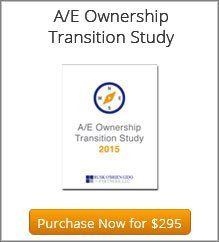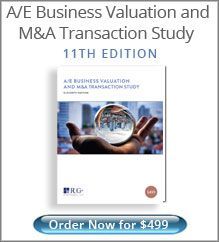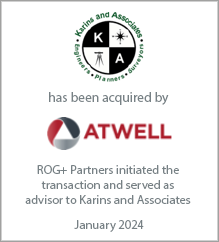With nearly fifteen years of corporate financial advisory experience, Jonathan Voelkel has worked with hundreds of engineering, architecture, and environmental consulting firms across the U.S. and abroad, in all facets of mergers & acquisitions, valuation, ownership transition planning, equity incentive compensation, and ESOP advisory. Jonathan received his Bachelor of Arts (BA) degree in Economics from Johns Hopkins University.
My Company Will Sell For 5x (or 6x or 7x) Earnings… Right?
My Company Will Sell For 5x (or 6x or 7x) Earnings… Right?
November 17, 2018
How often have you thought about the level of profit your firm generates and applied a multiple to that profit to estimate the value of your firm as if you were to sell it to an outside buyer? How often have you heard owners of peer firms say something to the effect of, “So and so just sold their company for 8 times earnings, so that’s what we’re going to get for our firm!”
When talking about M&A valuations, owners often think about the potential sale valuation of their company in terms of pricing multiples. A/E firm owners typically rely on multiples of “profit,” which is common for mature companies in established industries/markets for which substantial pricing data exists, but the question that must be asked when discussing multiples is, “Are we talking about profit in the same terms?” (Is this an apples to apples comparison?)
I’ve had discussions about this very topic with enough clients that I thought it might make sense for me to turn to the data to help more clearly illustrate why the question earlier about comparable measures of profit is important to understand.
To begin, I created a random basket of twenty M&A transactions that included engineering, architecture, and environmental consulting firms as the acquired parties. Focusing on EBIT (earnings before interest and taxes) and EBITDA (earnings before interest, taxes, and depreciation/amortization), I was curious about what sort of variances existed between the implied pricing multiples (i.e. Enterprise Value / EBIT, Enterprise Value / EBITDA). Even though the asset structure of A/E firms is insubstantially affected by fixed assets, depreciation & amortization still do exist for the majority of A/E firms. For this particular basket, the median difference of EBITDA as compared to EBIT was 10.0% greater (meaning that for a hypothetical firm with EBIT of $2.0 million, its EBITDA would be $2.2 million) and the median multiples of EBITDA and EBIT were 5.64x and 6.20x, respectively.
Why was this important? Because of the unintended consequences of misapplying multiples to estimate value. If the owners of that same hypothetical firm that was generating $2.2 million in EBIT were unwittingly relying on the 5.64x EBITDA multiple, their valuation would be understated by over $1 million at $11.2 million, instead of $12.4 million. Conversely, if the same firm was generating $2.2 million in EBITDA, but the owners were mistakenly applying the 6.20x EBIT multiple, their valuation would be overstated by over $1 million at $13.6 million.
Other potential missteps we encounter with clients are derived directly from compensation issues. Owner-specific compensation vs. return on investment is the most frequent consideration that must be factored when calculating a firm’s EBIT and EBITDA. Some firm owners will take bonuses in lieu of distributions. How much of an owner’s bonus should truly be characterized as a return on investment rather than as income? In order to get as close as possible to apples to apples comparison on an EBIT and EBITDA level, it is always best to look at it from a buyer’s perspective. What are the earnings they are buying, and what expenses will continue to keep the current owners and employees around?
Only when these and other factors relevant to the comparability of measures of value have been taken into consideration, and the data your company is using (i.e. method of calculating a specific measure of earnings) lines up with the data that you’re relying on to talk about industry pricing multiples, can we begin to entertain the question: “My Company Will Sell For 5x (or 6x or 7x) Earnings… Right?”
When talking about M&A valuations, owners often think about the potential sale valuation of their company in terms of pricing multiples. A/E firm owners typically rely on multiples of “profit,” which is common for mature companies in established industries/markets for which substantial pricing data exists, but the question that must be asked when discussing multiples is, “Are we talking about profit in the same terms?” (Is this an apples to apples comparison?)
I’ve had discussions about this very topic with enough clients that I thought it might make sense for me to turn to the data to help more clearly illustrate why the question earlier about comparable measures of profit is important to understand.
To begin, I created a random basket of twenty M&A transactions that included engineering, architecture, and environmental consulting firms as the acquired parties. Focusing on EBIT (earnings before interest and taxes) and EBITDA (earnings before interest, taxes, and depreciation/amortization), I was curious about what sort of variances existed between the implied pricing multiples (i.e. Enterprise Value / EBIT, Enterprise Value / EBITDA). Even though the asset structure of A/E firms is insubstantially affected by fixed assets, depreciation & amortization still do exist for the majority of A/E firms. For this particular basket, the median difference of EBITDA as compared to EBIT was 10.0% greater (meaning that for a hypothetical firm with EBIT of $2.0 million, its EBITDA would be $2.2 million) and the median multiples of EBITDA and EBIT were 5.64x and 6.20x, respectively.
Why was this important? Because of the unintended consequences of misapplying multiples to estimate value. If the owners of that same hypothetical firm that was generating $2.2 million in EBIT were unwittingly relying on the 5.64x EBITDA multiple, their valuation would be understated by over $1 million at $11.2 million, instead of $12.4 million. Conversely, if the same firm was generating $2.2 million in EBITDA, but the owners were mistakenly applying the 6.20x EBIT multiple, their valuation would be overstated by over $1 million at $13.6 million.
Other potential missteps we encounter with clients are derived directly from compensation issues. Owner-specific compensation vs. return on investment is the most frequent consideration that must be factored when calculating a firm’s EBIT and EBITDA. Some firm owners will take bonuses in lieu of distributions. How much of an owner’s bonus should truly be characterized as a return on investment rather than as income? In order to get as close as possible to apples to apples comparison on an EBIT and EBITDA level, it is always best to look at it from a buyer’s perspective. What are the earnings they are buying, and what expenses will continue to keep the current owners and employees around?
Only when these and other factors relevant to the comparability of measures of value have been taken into consideration, and the data your company is using (i.e. method of calculating a specific measure of earnings) lines up with the data that you’re relying on to talk about industry pricing multiples, can we begin to entertain the question: “My Company Will Sell For 5x (or 6x or 7x) Earnings… Right?”
Latest Perspective
Perfecting the A/E Exit Strategy – Five Key Factors
An enormous A/E generation that kicked off their careers in the 1980s and subsequently started firms or became owners in the 1990s ...
© 2024
Rusk O'Brien Gido + Partners, LLC
Financial Experts for Architects, Engineers, and Environmental Consulting Firms









